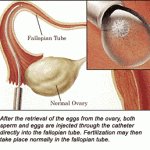Articles tagged with: fertilization
Artificial insemination, ICSI procedure »
One of the largest series reporting results using IVF/ICSI was from Van Steirteghem et al. at The Brussels Free University in Brussels, Belgium. In their preliminary report on 150 couples who underwent 150 consecutive treatment cycles, 1409 oocytes were injected and 830 were successfully fertilized for a fertilization rate of 59 percent. A total clinical pregnancy rate of 35 percent was achieved. The fertilization rate in this study was not influenced by the standard semen characteristics of concentration, motility, and strict criteria morphology. In another largest case serie on ICSI …
Artificial insemination, ICSI procedure »
Until recently, the clinical application of direct injection of a single sperm into the cytoplasm of an oocyte during IVF was not shown to be feasible. The demonstration of fertilization and live births by Palermo et al. in 1993 was the first successful application of ICSI. Since that time, ICSI has been performed extensively in multiple centers to treat patients with severe male factor infertility. To date, the success of ICSI procedures has been related to several factors: (1) the viability of the spermatozoon, (2) the quality of the oocyte, …
Artificial insemination, ICSI procedure »
ICSI stands for Intro Cytoplasmic Sperm Injection. The whole technique was developed by researches of Brussels University and a science institution in St. Louis, US. The amazing thing about ICSI procedure is that men who were considered ultimately unable to fertilize have succeeded in it and the procedure implication worldwide has already resulted in more than 10,000 babies and perfectly physically, genetically and mentally babies they are. You or your spouse might be the one for ICSI procedure if you are closely familiar with one of the following cases.
The …
Artificial insemination, ICSI procedure »
Intra-cytoplasmic sperm injection (ICSI) is a relatively new but well-established procedure first performed in 1992. The procedure was developed to help male factor infertility. The procedure involves injecting a single sperm into the cytoplasm of each egg using a fine glass needle. The first ICSI baby was reported in 1992. The ICSI has largely replaced the two previously developed procedures, PZD (partial zona dissection) and SUZI (subzonal insemination) because it achieves much higher fertilization rates.
The injection of immature sperm (spermatid) into the egg is not allowed in the UK because …
Artificial insemination, IVF procedure »
Pain. The patient may experience pain. It is not unusual for women to experience some abdominal or pelvic pain. A hot water bottle or painkillers are often helpful. However, if the pain is severe, or persists, then you should consult your doctor.
Bleeding. The patients may have to wear panty liners for a day or two following egg collection. Any bleeding should be minimal and dark or brown in colour. If bleeding is severe or bright red then consult your doctor.
Nausea and vomiting. The patient may experience nausea or vomiting for …
Artificial insemination, GIFT procedure »

In patients undergoing the gamete intra-Fallopian transfer (GIFT) procedure, a prospective study was perfonned to establish the predictive value of attempting in-vitro fertilization (IVF) using extra oocytes obtained at laparoscopy and also the value of transferring the resulting embryo(s), in conjunction with GIFT, in the same treatment cyde. The GIFT procedure was performed in 50 treatment cycles involving 43 patients, of whom 20 have achieved clinical pregnancy with an overall success rate of 40% per treatment cycle. In 38 of these patients, one or more extra oocytes were available and …